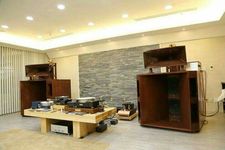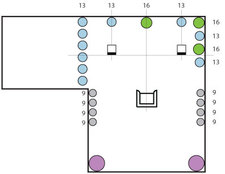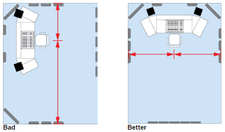It’s the time of year for saving money!
In the Chinese Classic, “The Art of War”, Sun Tzu wrote about “fighting without fighting” and described it as being a beneficial and effective way for a general to achieve his ends. I can’t tell you about warfare, but here, in this 7th Part of my continuing series on how to get the very most for your Hi-Fi dollar, I can at least tell you about “shopping without shopping” and show you how sometimes, by spending very little or nothing at all, you can still get better sound from your “High-Intention” home audio system.
 One way to do that is to find new or better ways to use what you’ve already got to get the sonic improvement you’re looking for, and a great deal of that can come just from understanding a few basic principles:
One way to do that is to find new or better ways to use what you’ve already got to get the sonic improvement you’re looking for, and a great deal of that can come just from understanding a few basic principles:
In earlier articles, I’ve already gone into the most important thing of all: the understanding that — unlike most “keeper” systems which, like home appliances, will likely just be bought and kept for as long as they keep on running –, a High Intention system is going to change over time as its owner’s interest, budget, and level of commitment change, and as new things come out to catch his buying fancy.
The next point is that the room your system plays in is an important part of your system, and needs to be recognized as such if you ever want your system to sound right. A “bad” room really can, all by itself, spoil the sound of an otherwise good system. (No, the opposite is NOT true: a great room WON’T make great sound from a poor system, but it WILL, at least, allow the system to be as good as it can be.) That’s why I said that, if your system really is High-Intention, you’ll need to have a “dedicated” listening room – one whose purpose is primarily – if not solely – serious or critical listening to music, and that if the room you’ve selected isn’t capable of good sound, you must either go to the effort (and possible expense) of making it better or, if possible, moving your system to a different room and starting over.
Whichever room you finally decide to use, it must be big enough to allow you to place your speakers far enough away from each other; from the side walls; and from the wall behind them for good imaging and for the creation of a believable “soundstage” without the “reflection” problems that too-close walls can create.
 Another PRIMARY consideration for a listening room is symmetry. As I said in Part 6, this is (after room size), by far the most important room requirement for good sound. Certainly having a room that is too “live” (echo-y) or too “dead” (an anechoic chamber, for example) can be a problem, but it’s a problem far more easily fixed than a room that’s- whether by its shape or because of the location or spacing of its doors, windows, walls and pass-throughs – asymmetrical.
Another PRIMARY consideration for a listening room is symmetry. As I said in Part 6, this is (after room size), by far the most important room requirement for good sound. Certainly having a room that is too “live” (echo-y) or too “dead” (an anechoic chamber, for example) can be a problem, but it’s a problem far more easily fixed than a room that’s- whether by its shape or because of the location or spacing of its doors, windows, walls and pass-throughs – asymmetrical.
The reason that symmetry is such a major concern is simple: Natural sounds – the sounds we hear “live” everyday – come from just a single source: whatever it is that’s making them. Recorded sounds, though, (the sounds we hear from our stereo system), come to us from at least TWO sources: from our speakers directly (two if for stereo, and maybe more, if for Home Theater) and indirectly, from the reflected sound of each of those speakers as it bounces off the walls, floor, and ceiling of our listening room. It is the arrival times of those sounds that allow us to experience an auditory “image” of whatever we’re listening to, and even of the venue (concert hall, studio, etc.) that it was recorded in. If our listening room is NOT symmetrical — if it’s different on either side of an imaginary line drawn from the room’s back wall to our listening position — (assuming that we’re sitting evenly distant from both speakers) the sounds coming to us from the speakers will arrive at our ears at the same time, but the sound reflected toward us off the room’s non-matching boundaries will arrive at different times, “confusing” the music’s image and soundstage or even destroying it entirely.
Take heart, though; room treatments really do work, even — though not always perfectly — to solve problems of room asymmetry.
 To use them properly, you first need to find the best basic layout and orientation for your system (particularly your speakers) and for the furniture in your listening room. Generally, that will be the arrangement that has your speakers lined-up a few feet in front of and centered-between the most symmetrical three walls (right side-wall, your “base” wall, and the left side-wall, for example) of your listening room, with your listening position centered between your speakers, at a distance from them at least as great as the distance they are apart. Setting your listening position (chair/chairs/couch, whatever) a few feet from the back wall (the one behind you when you’re listening) is a good idea, too. Remember, always, that this is your dedicated LISTENING ROOM, so, if you can, you should try to be more concerned with how things sound than how they look.
To use them properly, you first need to find the best basic layout and orientation for your system (particularly your speakers) and for the furniture in your listening room. Generally, that will be the arrangement that has your speakers lined-up a few feet in front of and centered-between the most symmetrical three walls (right side-wall, your “base” wall, and the left side-wall, for example) of your listening room, with your listening position centered between your speakers, at a distance from them at least as great as the distance they are apart. Setting your listening position (chair/chairs/couch, whatever) a few feet from the back wall (the one behind you when you’re listening) is a good idea, too. Remember, always, that this is your dedicated LISTENING ROOM, so, if you can, you should try to be more concerned with how things sound than how they look.
Once you’ve got your basic room layout, set up your system and listen to it, ignoring its imaging and soundstaging for the moment, and concentrating, instead, just on your speakers’ bass response. What does it sound like? Are you getting all you think your speakers ought to deliver? Does it go down deep enough? Is it “tight” and “punchy”? Or is it “soft” and “boomy”? If the sound of a kick-drum doesn’t “kick” the way you think it ought to, you may need “bass traps” in the corners (and/or along the walls) of your room to help eliminate boom and even certain “room nodes” that can make your woofers sound like they’re making less, less deep, or “softer” bass than they really are. Bass traps are readily available for not much money from any number of suppliers, or instructions and even actual plans for building and installing your own can be easily found on the Internet. Other kinds of acoustical treatments, from do-it-yourself-cheap-or-free to professionally-built for more money can be found there, too.
 You can find room treatments of all kinds, available at a broad range of price points, to solve almost every room problem. The thing to remember in selecting them is that, regardless of what else you might be told,, there are really only three basic kinds: “Absorbers”, as their name indicates, absorb excess acoustical energy to adjust your room’s effective frequency response and reverberation time (usually to make it “deader”). “Reflectors”, on the other hand, instead of sucking-up unwanted acoustical energy, reflect it – mirror-style – to bounce again or be absorbed at some other place in your room. Finally “diffusers” combine elements of both of the other kinds of treatment, to break-up (usually higher frequency) acoustical energy into multiple reflections at the same frequency but lower energy, and produce a sound that’s generally easier to live with and may – because the ratio of direct to reflected sound it produces may be increased at certain frequencies, the overall effect may be both a more pleasing tonality and better imaging and soundstaging.
You can find room treatments of all kinds, available at a broad range of price points, to solve almost every room problem. The thing to remember in selecting them is that, regardless of what else you might be told,, there are really only three basic kinds: “Absorbers”, as their name indicates, absorb excess acoustical energy to adjust your room’s effective frequency response and reverberation time (usually to make it “deader”). “Reflectors”, on the other hand, instead of sucking-up unwanted acoustical energy, reflect it – mirror-style – to bounce again or be absorbed at some other place in your room. Finally “diffusers” combine elements of both of the other kinds of treatment, to break-up (usually higher frequency) acoustical energy into multiple reflections at the same frequency but lower energy, and produce a sound that’s generally easier to live with and may – because the ratio of direct to reflected sound it produces may be increased at certain frequencies, the overall effect may be both a more pleasing tonality and better imaging and soundstaging.
Not only is it possible to make your system sound better by making or using the things I’ve just spoken of, it’s also possible to get outstanding results by using things that were never designed for that purpose at all. I’ll write about some of those next time.
I hope to see you then.








